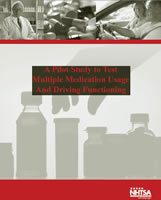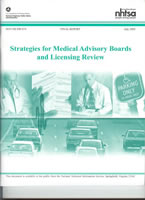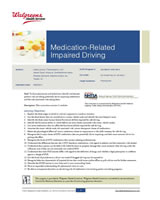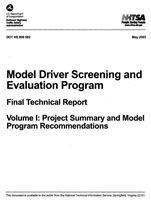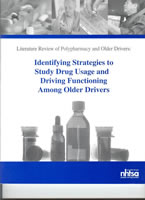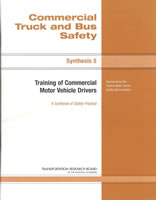Driver Competency and Fitness to Drive
The vast majority—approximately 90%—of traffic injuries and fatalities result from driver error. Some errors reflect transient states, chiefly drowsiness, distraction, or the influence of drugs/alcohol. In other cases, poor judgment or inadequate skills may reflect a deficit of education or training. Increasingly, given the changing demographics of our driving population, a loss of competency may be associated with disease, trauma, or age-related changes in the visual, physical, or mental abilities needed to drive safely; or with the side effects of medications used to treat medical conditions.
TransAnalytics has an impressive track record in projects to validate tools for screening and assessing safe driving abilities, and to evaluate education and training programs designed to improve driver competency. We have also evaluated driver examination methods, and developed new protocols used in Pennsylvania as interventions for negligent drivers. At the national level, we are leaders in research to measure the relationship between functional aging and crash risk, while complementary studies completed by our staff seek to better understand the impact of medication usage on driving. Results of this research include a curriculum on medication-related impaired driving as a continuing education (CE) course offering for pharmacists and pharmacy technicians. More broadly, our work will enhance processes for medical review of passenger car drivers at the State level, and inform Federal fitness-to-drive requirements for commercial vehicle operators.
A Pilot Study to Test Multiple Medication Usage and Driving Functioning
Loren Staplin, Kathy H. Lococo, Kenneth W. Gish and Carol Martell
The use of medications and multiple medications becomes more prevalent with increasing age. This pilot study explored the relationship between polypharmacy and driving functioning through separate but related research activities. A patient-level administrative claims database containing prescription information as well as E-codes identifying the incidence of motor vehicle injuries was mined, yielding combinations of drugs that became inclusion criteria in a following field study of driver performance among 44 older adults (range: 57-89; mean: 79). Driving performance evaluations by an OT/CDRS, a brake response time measure, and functional screening measures were conducted for the study sample, whose drug profiles were documented through a ‘brown bag’ review by a licensed pharmacist. The relationship between medication usage and each of these outcome measures was examined in descriptive data summaries and regression analyses. The driving evaluations were carried out in a dual-brake vehicle also equipped with speed sensor (OBD-2), GPS logger, and two miniature video cameras (driver’s face and forward road views) plus digital recorder. A subsample allowed the same instrumentation package to be installed in their private cars for a week of independent driving; this supported an analysis of within-subject variability in driving behavior during a formal driving evaluation versus independent driving.
Additional project activities included a current (to October 2007) review of the literature on the prevalence of prescription medications and effects on driving of specific drugs/drug classes. The feasibility of conducting future studies using large, administrative claims databases was critically examined, with an overview of candidates and evaluation of their suitability for NHTSA research. This report concluded with a discussion of project findings and recommendations for future research.
This work was performed for the National Highway Traffic Safety Administration; Office of Behavioral Safety Research; 1200 New Jersey Avenue, S.E.; Washington, DC 20590.
To access this report, please visit the following url: http://ntl.bts.gov/lib/30000/30200/30265/810980.pdf
Strategies for Medical Advisory Boards and Licensing Review
Kathy H. Lococo and Loren Staplin
This project documented the activities of the Medical Advisory Boards (MABs) and/or medical review units in the 50 United States plus the District of Columbia with respect to determining fitness to drive, and determined which activities currently applied by one or more jurisdictions deserve priority for consideration as recommended strategies, and how to implement them. Recommendations are provided for licensing agencies for the identification, assessment, and disposition of drivers with medical conditions and functional impairments, and related customer service goals.
The information obtained about medical review practices in the 51 driver-licensing agencies in the United States was obtained through requests of licensing officials to complete a survey, and then to participate in a follow-up telephone interview with the project Principal Investigator. An in-depth study was conducted next, to determine which activities currently applied by one or more driver-licensing agencies in the United States deserve priority for consideration as recommended strategies, and to provide suggestions that may facilitate the implementation of the recommended strategies. Discussions followed with licensing agency personnel and NHTSA and AAMVA representatives during a 1½-day meeting, to identify recommended strategies and barriers to their implementation. A true consensus regarding recommended strategies for most medical program components discussed at the meeting was rarely achieved; however, substantial agreement among participants was reached on a number of points, as documented in the final report for this project.
This work was performed for the National Highway Traffic Safety Administration; Office of Research and Traffic Records; 1200 New Jersey Avenue, S.E.; Washington, DC 20590.
To access this report, please visit the following url: http://www.nhtsa.dot.gov/people/injury/research/MedicalAdvisory/pages/ Executive.html
A Traffic Tech summary is available at:
http://www.nhtsa.dot.gov/portal/site/nhtsa/…(shortened)
Medication-Related Impaired Driving
Kathy H. Lococo and Loren Staplin
The central goal in this project was to develop a curriculum on medication-related impaired driving as a continuing education (CE) course offering for pharmacists and pharmacy technicians, in collaboration with an Accreditation Council for Pharmacy Education (ACPE) accredited co-sponsor. Working with Walgreen’s Health Initiatives (WHI) in this capacity, a 5-module course was developed: (1) Functional Abilities and Safe Driving; (2) Potentially Driver Impairing Medications—Prescription Drugs; (3) Potentially Driver Impairing Medications—Over-the-Counter Medications; (4) Laws Relating to Medication Use and Driving Under the Influence; and (5) Pharmacists’ Roles and Responsibilities in Counseling Patients Regarding Medications and Driving Risk.
Draft materials were reviewed by subject-matter experts in the fields of drug-impaired driving, medicine, gerontology, law enforcement, and the legal community. Prior to offering the CE on their website, WHI also conducted a peer review of these materials.
The curriculum was subsequently pilot tested using 640 pharmacists and 1,286 technicians from 46 States plus Puerto Rico. Curriculum effectiveness was evaluated using Learning Assessments (a pre-test and a post-test); a Program Evaluation rating the quality of the program and its usefulness to pharmacy practice; and a Follow-Up Evaluation to determine how often participants used the knowledge gained from the curriculum in their daily practice, in the month following completion of the CE. Paired t-tests found significant differences between the mean pre- and post-test scores for both pharmacists and technicians, indicating that the curriculum was effective in increasing participants’ knowledge of medication-related impaired driving.
It was recommended that the CE continue to be available to pharmacists and technicians at least through its current certification period of 3 years, and also be made available to other healthcare providers who routinely interact with older drivers, such as physicians and nurses.
This work was performed for the National Highway Traffic Safety Administration; Impaired Driving Division; 1200 New Jersey Avenue, S.E.; Washington, DC 20590
To access this report, please visit the following url:
https://webapp.walgreens.com/cePharmacy/viewpdf?fileName=transportation_tech.pdf
Model Driver Screening and Evaluation Program
Loren Staplin, Kathy H. Lococo, Kenneth W. Gish, and Lawrence E. Decina
This research project studied the feasibility as well as the scientific validity and utility of performing functional capacity screening with older drivers. A Model Program was described encompassing procedures to detect functionally impaired drivers who pose an elevated risk to themselves and others; to support remediation of functional limitations if possible; to provide mobility counseling to inform and connect individuals with local alternative transportation options; and to educate the public and professionals about the link between functional decline and driving safety-all within a larger context of helping to preserve and extend the mobility of older persons. Early in this project, a questionnaire was developed and distributed to Driver License Administrators in the U.S. and Canada to broadly determine cost and time parameters, while identifying legal, ethical, or policy implications that could influence implementation of Model Program activities. Subsequently, a battery of functional tests was developed and pilot tested in Motor Vehicle Administration sites, and in the community.
A database of scores on functional ability measures, driving habits information, and crash and violation history was created for over 2,500 drivers in three samples drawn from license renewal, medical referral, and residential community populations. Cost estimates for functional capacity screening and related Model Program activities were developed for research and production settings. A 477-page Safe Mobility for Older People Notebook (DOT HS 808 853) was developed to support program initiatives promoting the safe mobility of older persons across all States and Provinces, including an Annotated Research Compendium of Driver Assessment Techniques for Age-Related Functional Impairments. A set of guidelines for motor vehicle administrators was also produced to update the 1992 publication by NHTSA and AAMVA of the same title. Also see: “MaryPODS Revisited: Updated crash analysis and implications for screening program implementation,” Journal of Safety Research, 34, 389-397, 2003.
This work was performed for the National Highway Traffic Safety Administration; Office of Research and Traffic Records; 1200 New Jersey Avenue, S.E.; Washington, DC 20590.
To access this report, please visit the following url:
http://www.nhtsa.dot.gov/PEOPLE/injury/olddrive/modeldriver/volume_i.htm#Table%20of%20Contents
Polypharmacy and Older Drivers: Identifying Strategies to Study Drug Usage and Driving Functioning Among Older Adults
Kathy H. Lococo and Loren Staplin
This research product updates the state-of-the-knowledge regarding key factors that bear on NHTSA’s ability to investigate the effects of multiple medications on safe driving among older people. First, the prevalence of medication use by older people in the population, the physiological/metabolic effects of specific drugs and drug classes, and the known effects on driving ability—principally for single substances—are reviewed. Next, the strengths and weakness of various methods that may be used to learn which prescription and over-the-counter drugs are being taken by older adults are described and contrasted; a consideration of which factors most strongly affect compliance with a medication regime, and which factors influence older people’ willingness to participate in studies aimed at obtaining such information, complements this discussion.
The remaining section in this review examines on-road, closed course, and simulation methods that have been applied in this arena, highlighting those that appear to hold the greatest promise for evaluating the effects of drugs on driving performance while also acknowledging shortcomings and limitations that have been reported in the literature. For the most part, this review concentrates on recent (since 2001) studies accessed through print and electronic media. A bibliography containing over 200 citations is included, plus an appendix identifying potentially inappropriate medications commonly prescribed for older, community-dwelling individuals.
This work was performed for the National Highway Traffic Safety Administration; Office of Research and Technology; 1200 New Jersey Avenue, S.E.; Washington, DC 20590.
To access this report, please visit the following url:
http://www.nhtsa.dot.gov/people/injury/olddrive/DrugUse_OlderDriver/index.htm
A Traffic Tech summary is available at:
http://www.nhtsa.dot.gov/portal/site/nhtsa/… (shortened)
Training of Commercial Motor Vehicle Drivers
Loren Staplin, Kathy H. Lococo, Lawrence E. Decina and Gene Bergoffen
This is a research synthesis for the Commercial Truck and Bus Safety Synthesis Program (CTBSSP). It focused upon similarities and differences in training strategies and curricula among existing driver training programs, with a goal of identifying those CMV driver training tools and techniques that hold the greatest potential to improve commercial motor vehicle safety. In particular, the need to insure adequate knowledge and skills for entry-level drivers guided this research effort. It includes recommendations based on an exhaustive review of technical information sources, plus inputs from the trucking and motorcoach industries derived through survey responses solicited in this project, supplemented by comments to a 1993 Advanced Notice of Proposed Rulemaking (ANPRM) and a 2003 Notice of Proposed Rulemaking (NPRM) by the Federal Motor Carrier Safety Administration (FMCSA).
A number of practices for improving training effectiveness for entry-level CMV drivers are supported by this synthesis: Industry-wide acceptance of and adherence to standards put forward by the Professional Truck Driving Institute (PTDI) as a minimum requirement for entry-level (2nd seat) drivers, and for the certification of driver trainers; finishing training for 1st seat (solo) drivers; substitution of multimedia instructional materials, delivered via CD/DVD ROM, for traditional classroom presentations relying on printed materials; introduction/expansion of appropriate uses of affordable simulation options; expanding the use of skid pads to train beginning drivers about stopping distances under different load configurations; using different brake systems (including all ABS, mixed ABS and non-ABS) to experience the consequences of driving on a wet surface for handling and stopping the vehicle, including skid control; and employing videos, in concert with testimonials by experienced drivers, to give entry level trainees a realistic orientation to health, wellness, and lifestyle issues, and provide fitness-to-drive instruction.
This work was performed for the National Academy of Sciences/Transportation Research Board; 500 Fifth St., N.W.; Washington, DC 20001.
To access this report, please visit the following url:
http://www.trb.org/news/blurb_browse.asp?id=11
